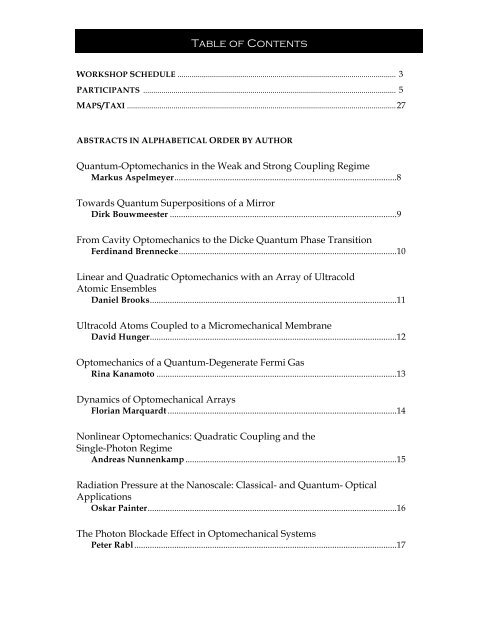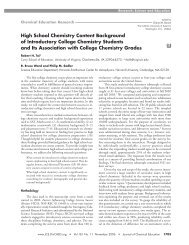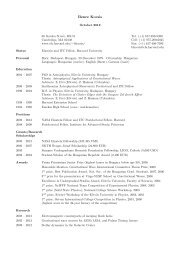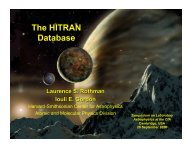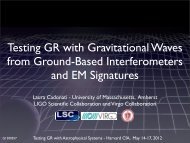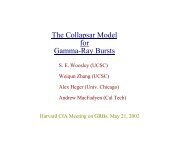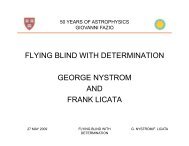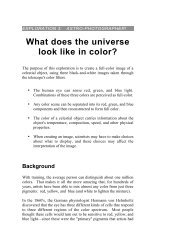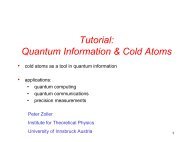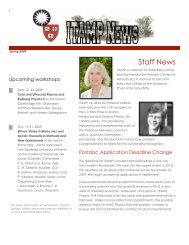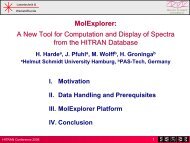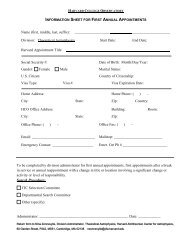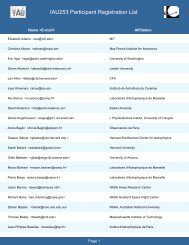Index OMC_final - Harvard University
Index OMC_final - Harvard University
Index OMC_final - Harvard University
Create successful ePaper yourself
Turn your PDF publications into a flip-book with our unique Google optimized e-Paper software.
Table of Contents<br />
WORKSHOP SCHEDULE ............................................................................................................ 3<br />
PARTICIPANTS ............................................................................................................................. 5<br />
MAPS/TAXI .....................................................................................................................................27<br />
ABSTRACTS IN ALPHABETICAL ORDER BY AUTHOR<br />
Quantum-Optomechanics in the Weak and Strong Coupling Regime<br />
Markus Aspelmeyer....................................................................................................8<br />
Towards Quantum Superpositions of a Mirror<br />
Dirk Bouwmeester ......................................................................................................9<br />
From Cavity Optomechanics to the Dicke Quantum Phase Transition<br />
Ferdinand Brennecke..................................................................................................10<br />
Linear and Quadratic Optomechanics with an Array of Ultracold<br />
Atomic Ensembles<br />
Daniel Brooks...............................................................................................................11<br />
Ultracold Atoms Coupled to a Micromechanical Membrane<br />
David Hunger...............................................................................................................12<br />
Optomechanics of a Quantum-Degenerate Fermi Gas<br />
Rina Kanamoto ............................................................................................................13<br />
Dynamics of Optomechanical Arrays<br />
Florian Marquardt .......................................................................................................14<br />
Nonlinear Optomechanics: Quadratic Coupling and the<br />
Single-Photon Regime<br />
Andreas Nunnenkamp ...............................................................................................15<br />
Radiation Pressure at the Nanoscale: Classical- and Quantum- Optical<br />
Applications<br />
Oskar Painter................................................................................................................16<br />
The Photon Blockade Effect in Optomechanical Systems<br />
Peter Rabl......................................................................................................................17
Table of Contents<br />
Optical Trapping and Cooling of Glass Microspheres<br />
Mark Raizen .................................................................................................................18<br />
Optomechanical Matter-Wave Interferometer for Microspheres<br />
Oriol Romero-Isart ......................................................................................................19<br />
Optomechanics with a Silicon Nitride Membrane Approaching the<br />
Quantum Regime<br />
Jack Sankey...................................................................................................................20<br />
Cavity Optomechanics: Beyond the Ground State<br />
Swati Singh...................................................................................................................21<br />
Optomechanical Cooling and Amplification in a Chip-Scale<br />
Integrated Circuit<br />
Hong Tang ....................................................................................................................22<br />
Circuit Cavity Electromechanics in the Strong Coupling Regime<br />
John Teufel ...................................................................................................................23<br />
A Phonon-Tunneling Approach to Clamping Losses of<br />
Mechanical Resonators<br />
Ignacio Wilson-Rae .....................................................................................................24<br />
Radiation Pressure and Quantum Noise<br />
Christopher Wipf ........................................................................................................25<br />
Hybrid Systems: Atoms and Opto-Nanomechanics<br />
Peter Zoller ..................................................................................................................26
Schedule<br />
MONDAY, FEBRUARY 7 Phillips Auditorium, ITAMP, 60 Garden St., Cambridge<br />
8:00 Morning Coffee & Pastry, Registration<br />
8:30 Introduction<br />
Session I Big Ideas I<br />
Chair: Pierre Meystre<br />
9:00 Peter Zoller | Hybrid Systems: Atoms and Opto-Nanomechanics<br />
9:40 Marcus Aspelmeyer | Quantum-Optomechanics in the Weak and Strong<br />
Coupling Regime<br />
10:20 Morning Break<br />
11:00 Mark Raizen | Optical Trapping and Cooling of Glass Microspheres<br />
11:40 Oriol Romero-Isart | Optomechanical Matter-Wave Interferometer for<br />
Microspheres<br />
12:20 Lunch<br />
Session II Big Ideas II<br />
Chair: Dan Stamper-Kurn<br />
2:00 Eric Adelberger | Low-Frequency Torsion Oscillators in Gravitational Physics<br />
2:40 Christopher Wipf | Radiation Pressure and Quantum Noise<br />
3:20 Dirk Bouwmeester | Towards Quantum Superpositions of a Mirror<br />
4:00 Break<br />
4:40 Panel Discussion: Konrad Lehnert, Ignacio Cirac, Mark Raizen, Oskar Painter<br />
Moderator: Nergis Mavalvala<br />
5:45-7 Reception: Perkin Lobby<br />
TUESDAY, FEBRUARY 8 Phillips Auditorium<br />
Session III State of the Art<br />
Chair: Konrad Lehnert<br />
9:00 Ferdinand Brennecke | From Cavity Optomechanics to the Dicke Quantum<br />
Phase Transition<br />
9:40 Dan Brooks | Linear and Quadratic Optomechanics with an Array of Ultracold<br />
Atomic Ensembles<br />
10:20 Break<br />
11:00 Rina Kanamoto | Optomechanics of a Quantum-Degenerate Fermi Gas<br />
11:40 Ignacio Wilson-Rae | A Phonon-Tunneling Approach to Clamping Losses of<br />
Mechanical Resonators<br />
3
Schedule<br />
12:20 Jack Sankey | Optomechanics with a Silicon Nitride Membrane Approaching<br />
the Quantum Regime<br />
1:00 Lunch<br />
Session IV State of the Art II<br />
Chair: Mark Raizen<br />
2:40 Tobias Kippenberg<br />
3:20 Florian Marquardt | Dynamics of Optomechanical Arrays<br />
4:00 John Teufel | Circuit Cavity Electromechanics in the Strong Coupling Regime<br />
WEDNESDAY, FEBRUARY 9 Phillips Auditorium<br />
8:30 Morning Coffee & Pastry<br />
Session V Hybrid Methods<br />
Chair: Oskar Painter<br />
9:00 Mukund Vengalattore|<br />
9:40 Swati Singh | Cavity Optomechanics: Beyond the Ground State<br />
10:20 Coffee<br />
11:00 Andreas Nunnenkamp | Nonlinear Optomechanics: Quadratic Coupling and<br />
the Single-Photon Regime<br />
11:40 Hong Tang | Optomechanical Cooling and Amplification in a Chip-Scale<br />
Integrated Circuit<br />
12:20 Lunch<br />
Session VI Hybrid Methods (cont’d)<br />
Chair: Juan Ignacio Cirac<br />
2:00 David Hunger | Ultracold Atoms Coupled to a Micromechanical Membrane<br />
2:40 Peter Rabl | The Photon Blockade Effect in Optomechanical Systems<br />
3:20 Thank You and Closing Thoughts<br />
Walk to Physics: Physics, <strong>Harvard</strong> <strong>University</strong>, Physics Colloquium Room: Jefferson 356<br />
4:00 Coffee in Jefferson 356<br />
4:30 JAPC Talk| Oskar Painter: Radiation Pressure at the Nanoscale: Classical- and<br />
Quantum-Optical Applications<br />
4
JAMIL ABO-SHAEER<br />
PARTICIPANTS<br />
Darpa, Jamil.Abo-Shaeer@Darpa.Mil<br />
ERIC ADELBERGER<br />
<strong>University</strong> Of Washington, Eric@Npl.Washington.Edu<br />
MARKUS ASPELMEYER<br />
NIR BAR-GILL<br />
<strong>University</strong> of Vienna, aspelmeyer-office@univie.ac.at<br />
<strong>Harvard</strong> <strong>University</strong>, Nbar-Gill@Cfa.<strong>Harvard</strong>.Edu<br />
STEVEN BENNETT<br />
<strong>Harvard</strong> <strong>University</strong>, bennett@physics.harvard.edu<br />
TIMOTHY BODIYA<br />
KJETIL BORKJE<br />
Massachusetts Institute of Technology, Bodtim@Mit.Edu<br />
Yale <strong>University</strong>, Kjetil.Borkje@Yale.Edu<br />
DIRK BOUWMEESTER<br />
UC Santa Barbara, bouwmeester@physics.ucsb.edu<br />
NATHAN BRAHMS<br />
UC Berkeley, Tatumd@Berkeley.Edu<br />
FERDINAND BRENNECKE<br />
DANIEL BROOKS<br />
Eth Zurich, Brennecke@Phys.Ethz.Ch<br />
UC Berkeley, tatumd@berkeley.edu<br />
ARAVIND CHIRUVELLI<br />
U niversity Of Arizona, Achiruvelli@Email.Arizona.Edu<br />
A. EGON CHOLAKIAN<br />
<strong>Harvard</strong> <strong>University</strong>, aecholakian@post.harvard.edu<br />
JUAN IGNACIO CIRAC<br />
Max-Planck Institute of Quantum Optics, Ignacio.cirac@mpq.mpg.de<br />
PETER HERSKIND<br />
Massachusetts Institute of Technology, herskind@mit.edu<br />
DAVID HUTCHISON<br />
Cornell <strong>University</strong> David.N.Hutch@Gmail.Com<br />
5
DAVID HUNGER<br />
PARTICIPANTS<br />
LMU Munich, david.hunger@physik.lmu.edu<br />
RINA KANAMOTO<br />
Ochanomizu <strong>University</strong>, kanamoto.rina@ocha.ac.jp<br />
UTKU KEMIKTARAK<br />
JOHN LAWALL<br />
NIST/JQI, kemiktau@umd.eu<br />
NIST, john.lawall@nist.gov<br />
KONRAD LEHNERT<br />
JILA, konrad.lehnert@jila.colorado.edu<br />
NERGIS MAVALVALA<br />
Massachusetts Institute of Technology, Nergis@Ligo.Mit.Edu<br />
FLORIAN MARQUARDT<br />
<strong>University</strong> Of Erlangen, florian.marquardt@physik.uni-erlangen.de<br />
PIERRE MEYSTRE<br />
<strong>University</strong> ofArizona, Pierre@optics.arizona.edu<br />
ANDREAS NUNNENKAMP<br />
ERIC OELKER<br />
OSKAR PAINTER<br />
Yale <strong>University</strong>, andreas.nunnenkamp@yale.edu<br />
Massachusetts Institute of Technology, Ericoelker@Gmail.Com<br />
Caltech, opainter@caltech.edu<br />
GREGORY PHELPS<br />
PETER RABL<br />
MARK RAIZEN<br />
<strong>University</strong> of Arizona, gphysics@email.arizona.edu<br />
Austrian Academy of Sciences, peter.rabl@uibk.ac.at<br />
<strong>University</strong> of Texas at Austin, raizen@physics.utexas.edu<br />
ORIOL ROMERO-ISART<br />
JACK SANKEY<br />
Max Planck Institute for Quantum Optics,<br />
oriol.romero-isart@mpq.mpg.de<br />
Yale Physics, jack.sankey@yale.edu<br />
6
MONIKA SCHLEIER-SMITH<br />
SWATI SINGH<br />
PARTICIPANTS<br />
Massachusetts Institute of Technology, schleier@mit.edu<br />
<strong>University</strong> of Arizona, swati@physics.arizona.edu<br />
DAN STAMPER-KURN<br />
UC Berkeley, dmsk@berkeley.edu<br />
STEVEN STEINKE<br />
HONG TANG<br />
JOHN TEUFEL<br />
EMRE TOGAN<br />
<strong>University</strong> of Arizona, Steinke@email.arizona.edu<br />
Yale <strong>University</strong>, hong.tang@yale.edu<br />
NIST – Boulder, john.teufel@nist.gov<br />
<strong>Harvard</strong> <strong>University</strong>, emretogan@gmail.com<br />
MUKUND VENGALATTORE<br />
AMAR VUTHA<br />
Cornell <strong>University</strong>, mukundv@cornell.edu<br />
Yale <strong>University</strong>, amar@cua.harvard.edu<br />
RENYUAN WANG<br />
Dsb25@Cornell.Edu<br />
IGNACIO WILSON-RAE<br />
Technical <strong>University</strong> Munich, Ignacio.wilson-rae@ph.tum.de<br />
CHRISTOPHER WIPF<br />
Massachusetts Institute of Technology Ligo, wipf@ligo.mit.edu<br />
BERNHARD WUNSCH<br />
HAO ZHANG<br />
PETER ZOLLER<br />
Bwunsch@Physics.<strong>Harvard</strong>.Edu<br />
Massachusetts Institute of Technology, htzhang@mit.edu<br />
Institute for Theoretical Physics, peter.zoller@uibk.ac.at<br />
7
QUANTUM-OPTOMECHANICS IN THE WEAK AND<br />
STRONG COUPLING REGIME<br />
Markus Aspelmeyer<br />
Unversity of Vienna<br />
I will discuss some of our current experiments to achieve quantum optical control over<br />
mechanical quantum states. This includes optomechanics using ultracold cryogenic cavities and<br />
the demonstration of optomechanical parametric downconversion, which is at the heart of<br />
optomechanical quantum entanglement..<br />
8
TOWARDS QUANTUM SUPERPOSITIONS OF A MIRROR<br />
Dirk Bouwmeester<br />
Department of Physics, <strong>University</strong> of California, Santa Barbara,<br />
& Huygens Laboratory, <strong>University</strong> of Leiden, the Netherlands<br />
Using a tiny mirror attached to a micromechanical resonator as one of the mirrors in an<br />
interferometer we aim to investigate macroscopic quantum superpositions. We analyze the effects<br />
of finite temperature on the proposed experiment and conclude that an unambiguous<br />
demonstration of a quantum superposition requires the mechanical resonator to be in or near the<br />
ground state. This can in principle be achieved by optical cooling of the fundamental mode,<br />
which also provides a method for measuring the mean phonon number in that mode. We also<br />
calculate the rate of environmentally induced decoherence and estimate the timescale for<br />
gravitational collapse mechanisms as proposed by Penrose and Diosi. We will show experimental<br />
data on optical cooling of an optical trampoline resonator starting from dilution refrigeration<br />
temperatures. Finally we discuss the technical challenges to be overcome in order to test quantum<br />
mechanics in the regime where gravitational effects might interfere.<br />
9
FROM CAVITY OPTOMECHANICS TO THE DICKE QUANTUM<br />
PHASE TRANSITION<br />
Ferdinand Brennecke<br />
Department of Physics, ETH Zürich, Switzerland<br />
Coupling the collective motion of ultracold gases to high-Q optical resonators provides an<br />
approach towards unexplored regimes in cavity optomechanics [1, 2]. In these mesoscopic<br />
systems, the ground state of the mechanical oscillator is naturally prepared by the initial cooling of<br />
the atomic gas. In our experiment, a Bose-Einstein condensate of about 10 5 alkali atoms is<br />
coupled dispersively to the single-mode field of an ultrahigh-finesse optical cavity. A collective<br />
density oscillation of the condensate serves as a mechanical element which couples to the cavity<br />
field intensity. We observe optical bistability already below the single-photon level and a strong<br />
backaction dynamics, in quantitative agreement with a cavity optomechanical model. The<br />
experiment reaches the strong coupling regime of cavity optomechanics, where already single<br />
mechanical excitations have a significant effect on the cavity field.<br />
In a different setting of the experiment exploiting the mechanical effects of light on quantum<br />
gases, we recently observed a non-equilibrium version of the Dicke quantum phase transition [3, 4,<br />
5]. A far-detuned pump field aligned perpendicular to the cavity axis induces a dipole-like<br />
interaction between the cavity field and a collective density wave. Above a critical pump strength<br />
the atoms self-organize on a checkerboard structure, which is associated with a spontaneously<br />
broken symmetry. The cavity decay channel allows us to extract valuable in-situ information about<br />
the system like its phase diagram, the appearance of spontaneous symmetry breaking, and the<br />
vanishing excitation gap close to the critical point. Our observations are quantitatively described<br />
by the Dicke model.<br />
References:<br />
[1] K. W. Murch, K.L. Moore, S. Gupta, D. M. Stamper-Kurn, Nature Physics 4, 561 (2008)<br />
[2] F. Brennecke, S. Ritter, T. Donner, T. Esslinger, Science 322, 235 (2008) [<br />
[3] K. Baumann, C. Guerlin, F. Brennecke, T. Esslinger, Nature 464, 1301 (2010)<br />
[4] R. H. Dicke, Phys.Rev 93(1), 99 (1954)<br />
[5] K. Hepp, E.H. Lieb, Annals of Physics 76(2), 360 (1973)<br />
10
LINEAR AND QUADRATIC OPTOMECHANICS WITH AN ARRAY OF<br />
ULTRACOLD ATOMIC ENSEMBLES<br />
Daniel Brooks<br />
UC Berkeley<br />
Atomic ensembles have a number of advantages as optomechanical oscillators . They can be<br />
cooled to their motional ground state using atomic cooling techniques, have very low thermal<br />
coupling to the surrounding environment, and can be probed in the single-photon strong coupling<br />
regime. We present an experiment using an integrated atom-chip/cavity device operated with<br />
atoms initialized in their motional ground state. Strong magnetic-field gradients from the atom<br />
chip allow us to prepare atomic ensembles centered on locations that are primarily either linearly<br />
or quadratically coupled to the cavity field. In addition, we can alter the light-atom coupling<br />
strength of neighboring atomic ensembles in a 1D array by using a magnetic resonance technique<br />
to address the atomic spin. We also present ongoing studies of the linear optomechanical gain of<br />
the atom-cavity device driven by near shot-noise fluctuations of the light.<br />
11
ULTRACOLD ATOMS COUPLED TO A MICROMECHANICAL MEMBRANE<br />
David Hunger, 1,2 Stephan Camerer, 1,2 Maria Korppi, 1,2,3<br />
Andreas J ̈ockel, 1,2,3 Theodor W. H ̈ansch, 1,2 and Philipp Treutlein 1,2,3<br />
1Max-Planck-Institute of Quantum Optics, Garching, Germany<br />
2Faculty of Physics, Ludwig-Maximilians-<strong>University</strong> Munich, Germany<br />
3Department of Physics, <strong>University</strong> of Basel, Switzerland<br />
E-mail: philipp.treutlein@unibas.ch<br />
We report the observation of bi-directional coupling between a mechanical oscillator and the<br />
center-of-mass motion of ultracold atoms. Our experiment realizes a recently proposed system [1]<br />
in which an optical lattice mediates a long-distance coupling between laser-cooled atoms and a<br />
micromechanical membrane. We detect both the effect of the vibrating membrane onto the<br />
atoms as well as the effect of the atoms onto the membrane and find reasonable agreement with a<br />
simple theoretical model. Coupling ultracold atoms to mechanical oscillators opens the exciting<br />
perspective of using the tools of atomic physics to read out, cool, and coherently manipulate the<br />
oscillators’ state [2, 3, 4].<br />
Figure 1: Schematic of our setup: A laser field impinging from the right is partially reflected off a dielectric<br />
membrane and forms a standing wave optical potential for an atomic ensemble. Vibrations of the<br />
membrane’s fundamental mode will shift the standing wave field, shaking atoms in the optical lattice.<br />
Conversely, oscillations of the atomic cloud (center of mass motion) will change the intensity of left/right<br />
propagating field components, thus shaking the membrane via changing the radiation pressure on it.<br />
References:<br />
[1] K. Hammerer, K. Stannigel, C. Genes, P. Zoller, P. Treutlein, S. Camerer, D. Hunger, and T. W. H ̈ansch, Phys.<br />
Rev. A 82 021803 (R) (2010).<br />
[2] D. Hunger, S. Camerer, T. W. H ̈ansch, D. K ̈onig, J. P. Kotthaus, J. Reichel, and P. Treutlein, Phys. Rev. Lett.<br />
104, 143002 (2010).<br />
[3] P. Treutlein, D. Hunger, S. Camerer, J. Reichel, T. W. H ̈ansch, and P. Treutlein, Phys. Rev. Lett. 99, 140403<br />
(2007).<br />
[4] K. Hammerer, M. Wallquist, C. Genes, M. Ludwig, F. Marquardt, P. Treutlein, P. Zoller, J. Ye, and H. J. Kimble,<br />
Phys. Rev. Lett. 103, 063005 (2009). [4] V. M. Acosta, E. Bauch, A. Jarmola, L. J. Zipp,<br />
M. P. Ledbetter, and D. Budker, Broadband magnetometry by infrared-absorption detection of diamond NV centers<br />
[5] M.P. Ledbetter, C.W. Crawford, A. Pines, D.E. Wemmer, S. Knappe, J. Kitching, and D. Budker, Optical<br />
detection of NMR J-spectra at zero magnetic field, Journal of Magnetic Resonance 199 (2009) 25 29<br />
[6] L.-S. Bouchard, V. M. Acosta, E. Bauch, and D. Budker, Detection of the Meissner Effect with a Diamond<br />
Magnetometer<br />
12
OPTOMECHANICS OF A QUANTUM DEGENERATE FERMI GAS<br />
Rina Kanamoto<br />
Division of Advanced Sciences, Ochanomizu <strong>University</strong><br />
We provide a “bottom up” approach to cavity optomechanics [1,2,3] by exploring the interaction<br />
between a light field and a mechanical mode of a quantum-degenerate Fermi gas inside a Fabry-<br />
Pérot cavity [3]. Analogous to the momentum side-mode excitations of a bosonic condensate [2],<br />
the low-lying phonon modes of the fermions are collective density oscillations associated with<br />
particle-hole excitations. The mechanical modes of the fermions hence behave as moving mirrors.<br />
We derive an effective Hamiltonian and propose the observation of optical bistability as an<br />
experimental signature of the optomechanical coupling.<br />
Momentum side modes of cold atoms<br />
References:<br />
[1] K.W. Murch, K.L. Moore, S. Gupta, and D.M. Stamper-Kurn, Nature Physics 4, 561 (2008)<br />
[2] F. Brennecke, S. Ritter, T. Donner, and T. Esslinger, Science 322, 235 (2008)<br />
[3] R. Kanamoto and P. Meystre, Physical Review Letters 104, 063601 (2010)<br />
13
DYNAMICS OF OPTOMECHANICAL ARRAYS<br />
Florian Marquardt<br />
Departments of Physics and Applied Physics, Yale <strong>University</strong><br />
In this talk I will address novel features that may be observed in multi-mode optomechanical<br />
systems. I will describe the impact of multi-mode dynamics on phonon lasing (self-induced<br />
optomechanical oscillations). There, Landau-Zener Stueckelberg dynamics of the light field<br />
drastically changes the nonlinear dynamics. I will also describe synchronisation of<br />
optomechanical self-oscillations in an array of coupled oscillators.<br />
14
NONLINEAR OPTOMECHANICS: QUADRATIC COUPLING AND THE<br />
SINGLE-PHOTON REGIME<br />
Andreas Nunnenkamp<br />
Departments of Physics and Applied Physics, Yale <strong>University</strong><br />
In optomechanical systems optical and mechanical degrees of freedom are coupled via radiation<br />
pressure, optical gradient, or photothermal forces. To date, the theoretical literature has focused<br />
on systems where the position of the mechanical oscillator is coupled parametrically to the cavity.<br />
In this case, the equations can often be linearized and thus solved exactly.<br />
Motivated by experiments with the membrane-in-the-middle geometry, I will explore the physics<br />
of optomechanical systems in which an optical cavity mode is coupled parametrically to the square<br />
of the position of a mechanical oscillator. In particular, I will derive an effective master equation<br />
describing two-phonon cooling of the mechanical oscillator and show that for high temperatures<br />
and weak coupling, the steady-state phonon number distribution is non-thermal (Gaussian).<br />
Moreover, I will discuss systems where the position of the mechanical oscillator is coupled<br />
parametrically to the cavity, but the equations cannot be linearized. One example is recent<br />
experiments with ultracold atoms in optical resonators which have reached the regime where a<br />
single photon displaces the mechanical oscillator by more than its zero-point uncertainty. I will<br />
show how this can be detected by probing the outgoing light.<br />
Some of these results I will present have been published in PRA 82, 021806(R) (2010).<br />
15
RADIATION PRESSURE AT THE NANOSCALE: CLASSICAL AND<br />
QUANTUM-OPTICAL APPLICATIONS<br />
Oskar Painter<br />
Thomas J. Watson, Sr., Laboratory of Applied Physics,<br />
California Institute of Technology<br />
In the last several years, rapid advances have been made in the field of cavity optomechanics, in<br />
which the usually feeble radiation pressure force of light is used to manipulate (and precisely<br />
monitor) mechanical motion. These advances have moved the field from the multi-km<br />
interferometer of a gravitational wave observatory, to the optical table top, and now all the way<br />
down to a silicon microchip. In this talk I will describe these advances, and discuss our own work<br />
to realize radiation pressure within nanoscale structures in the form of photonic and phononic<br />
crystals (dubbed optomechanical crystals) and coupled microring cavities. Applications of these<br />
new nano-opto-mechanical systems include: all-optically tunable photonics, optically powered RF<br />
and microwave oscillators, and precision force/acceleration and mass sensing. Additionally there<br />
is the potential for these nanomechanical systems to be used in hybrid quantum networks,<br />
enabling storage or transfer of quantum information between disparate quantum systems. I will<br />
introduce several conceptual ideas regarding phonon-photon translation and slow light effects<br />
which may be used in such quantum settings, and discuss recent experiments to realize them in<br />
practice.<br />
16
THE PHOTON BLOCKADE EFFECT IN OPTOMECHANICAL SYSTEMS<br />
Peter Rabl<br />
Iqoqi, Austrian Academy of Sciences<br />
The implementation of strong optical non-linearities on a single photon level is one of the central<br />
themes in quantum optics and over the past years many setting based on atomic cavity QED have<br />
been discussed to achieve this goal. A very different type of light-matter interactions occurs in<br />
optomechanical systems where photons are coupled to mechanical motion via radiation pressure<br />
forces. Recent experiments have shown that the single photon strong coupling regime of<br />
optomechanics is within reach and might open a completely new route towards non-linear<br />
quantum optics. As a most pronounced signature of strong photon interactions I will discuss in<br />
this talk the appearance of a photon blockade effect in weakly driven optomechanical systems. I<br />
will show that an intuitive interpretation of this effect can be given in terms of displaced oscillator<br />
states and identify the parameter regime which is required to observe non-classical anti-bunching<br />
and photon blockade effects in experiments.<br />
17
OPTICAL TRAPPING AND COOLING OF GLASS MICROSPHERES<br />
Mark Raizen<br />
<strong>University</strong> of Texas<br />
In this talk I will report on our experiments with glass microspheres trapped in optical tweezers in<br />
air and in vacuum. In the air experiments, we have measured for the first time the instantaneous<br />
velocity of a Brownian particle, following a prediction by Albert Einstein from 1907. In our<br />
experiments with a trapped microsphere in vacuum, we have cooled the center-of-mass motion to<br />
1.5 mK, on the way towards ground-state cooling.<br />
18
OPTOMECHANICAL MATTER-WAVE INTERFEROMETER FOR<br />
MICROSPHERES<br />
Oriol Romero-Isart<br />
Max Planck Institute For<br />
Quantum Optics<br />
In this talk I will first review the proposal of using optically levitating objects for cavity quantum<br />
optomechanics as well as some proposals to prepare and measure quantum superposition states.<br />
Then, I will show how a matter-wave interferometer for microspheres can be realized using<br />
optomechanics. This opens up the possibility to explore a new parameter regime in the mass of<br />
the object (containing billions of atoms), and the size of the quantum superposition (orders of<br />
magnitude larger than the ground state size) used in the interferometer. I will analyze its viability<br />
under realistic experimental parameters and its potential application to provide unprecedented<br />
bounds to objective collapse models of the wavefunction.<br />
19
OPTOMECHANICS WITH A SILICON NITRIDE MEMBRANE<br />
APPROACHING THE QUANTUM REGIME<br />
Jack Sankey<br />
Yale <strong>University</strong><br />
A major goal in optomechanics is to observe and control quantum behavior in a system consisting<br />
of a solid mechanical element coupled to an optical cavity. Work toward this goal has traditionally<br />
focused on increasing the strength of this coupling; however, the form of the coupling is crucial in<br />
determining what phenomena are observable.<br />
Here I will demonstrate that avoided crossings in the spectrum of an optical cavity containing a<br />
flexible dielectric membrane allow us to realize several different forms of the optomechanical<br />
coupling. These include cavity detunings that are (to lowest order) linear, quadratic, or quartic in<br />
the membrane's displacement, and a cavity finesse that is linear in (or independent of) the<br />
membrane's displacement. All the couplings are realized in a single device with extremely low<br />
optical loss and can be tuned over a wide range in situ; in particular, we find that the quadratic<br />
coupling can be increased three orders of magnitude beyond previous devices. As a result of these<br />
advances, the device presented here should be capable of demonstrating the quantization of the<br />
membrane's mechanical energy.<br />
I will also discuss our recent efforts to laser cool the membrane's vibrations into the quantum<br />
regime. By coupling free-space laser light from room temperature into a 300 mK cryostat we have<br />
cooled the membrane's motion from a phonon occupancy of 30,000 to roughly 10. Using a<br />
recently-implemented heterodyne measurement we hope to both extract signatures of quantum<br />
behavior in the membrane's motion and measure a phonon occupancy close to zero.<br />
20
CAVITY OPTOMECHANICS: BEYOND THE GROUND STATE<br />
Swati Singh<br />
<strong>University</strong> of Arizona<br />
The talk will review some of our recent theoretical work in optomechanics, starting with a<br />
discussion of an optical spring approach to ground state cooling, and then turning to more recent<br />
work on the use of hybrid optomechanical systems as sensitive arrangements to induce and<br />
quantify the back-action of quantum measurements on macroscopic systems. If time permits, I<br />
will conclude with a presentation of novel methods to generate non-classical states in mechanical<br />
cantilevers.<br />
21
OPTOMECHANICAL COOLING AND AMPLIFICATION IN A CHIP-SCALE<br />
INTEGRATED CIRCUIT<br />
Hong Tang<br />
Yale <strong>University</strong><br />
I will describe our efforts in developing integrated circuits of cavity optomechanics on a silicon<br />
compatible chip. A progressive path for scaling optomechanical structures to smaller size, higher<br />
frequency and stronger coupling will be presented. We will show several promising applications<br />
stemming out on-chip cooling and amplification functions.<br />
22
CIRCUIT CAVITY ELECTROMECHANICS IN THE STRONG<br />
COUPLING REGIME<br />
John Teufel<br />
NIST – Boulder<br />
In the longstanding endeavor to access the quantum nature of macroscopic mechanical motion,<br />
the experimental challenge is not only that of state preparation, but also one of measurement.<br />
The flourishing field of cavity opto- and electro-mechanics, in which an electromagnetic<br />
resonance couples parametrically to a mechanical oscillator, addresses both of these challenges—<br />
providing a nearly ideal architecture for both manipulation and detection of mechanical motion<br />
at the quantum level. In this talk, I present experiments in which the motion of a high-Q,<br />
micromechanical membrane couples to a superconducting microwave resonator. When the<br />
circuit is excited with a coherent microwave tone near the cavity resonance, the displacement of<br />
the oscillator becomes encoded as modulation of this tone. The microwaves, in turn, also impart<br />
forces back on the oscillator which enforce the Heisenberg limits on measurement, and can also<br />
be exploited to either cool or amplify the motion. The unprecedented electromechanical<br />
coupling strength allows the driven system to enter the strong- coupling regime, where the normal<br />
modes are now hybrids of the original radio-frequency mechanical and the microwave electrical<br />
resonances. This normal-mode splitting is verified by direct spectroscopy of the ‘dressed states’ of<br />
the hybridized cavity resonance, showing excellent agreement with theoretical predictions. As all<br />
of these experiments take place in at a temperature below 40 mK, this system operates in the<br />
quantum enabled regime where the thermal decoherence rate is small enough to allow sideband<br />
cooling of the mechanical mode to the ground state. By measuring the noise spectrum of this<br />
mechanical system with a nearly quantum-limited microwave amplifier, the residual thermal<br />
motion of the oscillator is easily resolvable above the measurement imprecision. The <strong>final</strong> part of<br />
this talk will quantify the thermal motion of the oscillator as it is cooled with radiation-pressure<br />
forces to below its quantum zero-point motion and enters the strong coupling regime.<br />
23
A PHONON-TUNNELING APPROACH TO CLAMPING LOSSES OF<br />
MECHANICAL RESONATORS<br />
Ignacio Wilson-Rae<br />
Technische Universit ̈at M ̈unchen<br />
State of the art optomechanical and nanomechanical setups are close to allowing for the<br />
observation of quantum effects in a “macroscopic” mechanical system. A ma jor challenge that<br />
remains to be addressed is understanding and controlling mechanical dissipation in these systems.<br />
Here we analyze the dissipation mechanism induced by the unavoidable coupling of the resonator<br />
to the substrate (known as clamping losses). We follow a Hamiltonian treatment and derive the<br />
Caldeira-Leggett model that determines the quantum Brownian motion of a given resonance<br />
starting from the elastic scattering eigenmodes of the entire structure including the substrate. Our<br />
“phonon tunneling” approach provides the leading contribution in the aspect ratio or, more<br />
generally, in kRd, where 1/kR is the characteristic length scale over which the resonator mode<br />
varies appreciably and d the characteristic dimension of the contact area from which the<br />
resonator is suspended. This yields a “master formula” for the dissipation 1/Q that is applicable<br />
to a very wide range of high-Q resonators including planar structures (e.g. bridges), pedestal<br />
geometries (e.g. microdisks), and single-walled carbon nanotubes (CNT). The resulting limits for<br />
the Q-values have a strong geometric character.<br />
This master formula for the dissipation, has allowed us to develop an efficient FEM-enabled<br />
numerical method that can be used as an aid to design in order to minimize the clamping loss of<br />
complex geometries. We apply this concept to free-free micromirror structures relevant for Fabry-<br />
Perot based optomechanics. In addition, this design allows to isolate support-induced losses from<br />
other dissipation channels. Thus, we perform a rigorous test of the theory developed and<br />
demonstrate the strong geometric dependence of this loss mechanism. Furthermore, we analyze<br />
the case of high-stress nanomechanical resonators and test the theory on Si3 N4 membranes with<br />
circular and square geometries. The Q-values of different harmonics present a striking nonmonotonic<br />
behavior which is successfully explained. For the circular geometry we identify a class<br />
of modes for which destructive interference of the radiated waves leads to an exponential<br />
suppression of the damping rate as the harmonic index is increased, rendering these modes<br />
effectively clamping-loss free. This may provide a route towards ultra-high-Q nanomechanics and<br />
is directly relevant to dispersive optomechanical setups utilizing a thin membrane. In addition to<br />
furnishing reliable predictions for the design-limited Q, our approach allows to determine the<br />
spectrum of the environment. This is relevant to analyze the quantum regime in scenarios where<br />
the resonator is strongly coupled to an anharmonic system or exhibits strong nonlinearity.<br />
24
RADIATION PRESSURE AND QUANTUM NOISE<br />
Christopher Wipf<br />
Massachusetts Institute of Technology<br />
Laser Interferometer Gravitational-Wave Observatory<br />
In LIGO, optomechanical displacement sensing at the quantum limit is needed in order to meet<br />
the challenge of observing gravitational waves. Optical forces play an important role in this limit,<br />
determining both the classical dynamics and the noise properties of the system. I will discuss<br />
experiments underway in our lab, aimed at revealing these classical and quantum radiation<br />
pressure effects.<br />
25
HYBRID SYSTEMS: ATOMS AND OPTO-NANOMECHANICS<br />
Peter Zoller<br />
Institute for Theoretical Physics, <strong>University</strong> of Innsbruck<br />
Institute for Quantum Optics and Quantum Information, Austrian Academy of Sciences, Innsbruck, Austria<br />
We discuss a range of problems considering the interaction of atomic ensembles in free space and<br />
inside cavities with opto-nanomechanical oscillators. Topics to be discussed include: Optical<br />
lattices with micromechanical mirrors [1], strong coupling of a single atom to an oscillator in<br />
CQED [2,3], and establishing continuous variable EPR correlations between atomic ensembles and<br />
a opto-nanomechanical system [4].<br />
References:<br />
[1] K. Hammerer, K. Stannigel, C. Genes, P. Zoller, P. Treutlein, S. Camerer, D. Hunger, and T. W.<br />
Hänsch, Phys. Rev. A 82, 021803(R) (2010)<br />
[2] M. Wallquist, K. Hammerer, P. Zoller, C. Genes, M. Ludwig, F. Marquardt, P. Treutlein, J. Ye, and<br />
H. J. Kimble, Phys. Rev. A 81, 023816 (2010)<br />
[3] K. Hammerer, M. Wallquist, C. Genes, M. Ludwig, F. Marquardt, P. Treutlein, P. Zoller, J. Ye, and<br />
H. J. Kimble Phys. Rev. Lett. 103, 063005 (2009)<br />
[4] K. Hammerer, M. Aspelmeyer, E. S. Polzik, and P. Zoller, Phys. Rev. Lett. 102, 020501 (2009)<br />
26
!<br />
!<br />
!<br />
!<br />
!<br />
!<br />
!<br />
!<br />
!<br />
!<br />
!<br />
!<br />
!<br />
!<br />
!<br />
!<br />
!<br />
!<br />
!<br />
!<br />
!<br />
!<br />
!<br />
"#$%&!'(!)*+,-./!,-!01!2,3/.4!5-3..-6!7,893'/:.!;8,3.!E4)',-!->.3.!,3.!4*!+,9(!,?,'),9).!,-!->.!(-,4/!>.3.!,3.!-=*!)*+,)!!<br />
I>*4.!4E89.3(J!<br />
!<br />
$89,((,/*3L!MN0MONPQANMM11!<br />
R.))*=L!!MN0MONSPONT111!<br />
!<br />
!<br />
27<br />
!
!<br />
!<br />
"B!F*E!,3.!=,)-(!,-!U'44.,4!5-J!,4/!2,3/.4!5-J!!<br />
28<br />
#>.!G/3'?.=,FH!<br />
)**.!01!2,3/.4!5-J!!<br />
#>.!=*3*I!='))!<br />
9.!>.)/!'4!&>'))'I(!<br />
$E/'-*3'E8J!#>'(!'(!<br />
8,3.3.!'(!-*!<br />
+*4-'4E.!EI!->.!<br />
/3'?.=,F!,=,F!B3*8!<br />
2,3/.4!5-3..-J!!<br />
W>.4!F*E!3.,+>!->.!<br />
.4/!*B!->.!3./!93'+,-!<br />
,++.4/!-*!->.!=>'-.!<br />
/**3(!*B!->.!<br />
$E/'-*3'E8!/'3.+-)F!<br />
'4!B3*4-!*B!F*EJ!


